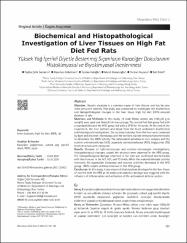Biochemical and histopathological investigation of liver tissues on high fat diet fed rats

Göster/
Erişim
info:eu-repo/semantics/openAccessTarih
2022Yazar
Samancı, Tuğba ÇelikGökçimen, Alpaslan
Kuloğlu, Tuncay
Boyacıoğlu, Murat
Kuyucu, Yurdun
Polat, Sait
Üst veri
Tüm öğe kaydını gösterKünye
Samanci, T.C., Gokcimen, A., Kuloglu, T., Boyacioglu, M., Kuyucu, Y. & Polat, S. (2022). Biochemical and Histopathological Investigation of Liver Tissues on High Fat Diet Fed Rats. Meandros Medical and Dental Journal, 23(1), 101-107. http://doi.org/10.4274/meandros.galenos.2021.32932Özet
Objective: Hepatic steatosis is a common cause of liver disease and has become more prevalent recently. This study was conducted to investigate the biochemical and histopathological changes in the liver tissue high fat diet (HFD)-induced steatosis in rats.
Materials and Methods: In this study, 16 male Wistar-albino rats (160 +/- 30 g in weight) were used and divided into two groups: The normal fed diet group fed with a standard diet and the HFD group fed with a HFD for 10 weeks. At the end of the experiment, the liver sections and blood from the heart underwent biochemical and histological investigations. The sections obtained from the liver were examined by light and electron-microscopy and the sections stained immunohistochemically to determine the iNOS activity. The antioxidant activities in liver samples and the alanine aminotransferase (ALT), aspartate aminotransferase (AST), triglyceride (TG) levels in serum were measured.
Results: Because of light-microscopy and electron-microscopic investigations, histopathological changes caused the steatosis were observed in the HFD group. The histopathological damage observed in the liver was confirmed biochemically with the increase in the ALT, AST, and TG levels. While the malondialdehyde activity increased, the superoxide dismutase and catalase activities decreased in the HFD group. iNOS enzyme activity increased in the HFD group.
Conclusion: In this study, it was observed that steatosis developed in the liver tissue of rats fed with the HFD at 10 weeks and oxidative damage was triggered with the influence of inflammation and activation of the antioxidant defense system.

















